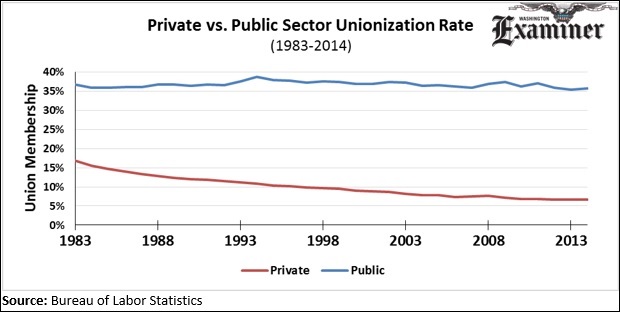The Bureau of Labor Statistics reported Friday that membership in a labor organizations had fallen to it lowest level yet, comprising just 11.1 percent of all wage and salary workers.
The number was a modest decline of 0.2 percent from the previous year and continues the movement’s gradual decline over the last few decades. It has dropped nine percentage points from its high of 20.1 percent in 1983, the first year the Labor Department began tracking the number.
The BLS’s data showed that just 6.6 percent of private sector workers now belong to a union, while 35.7 percent of all public sector workers — people employed by the government at some level — are members.
Overall, there are 14.6 million people in unions, with the private sector ones only slightly exceeding the public sector ones in total numbers, 7.4 million to 7.2 million.
The worker groups most likely to be unionized were those in education and related fields such training and library work as well people in “protective services,” i.e. law enforcement. Farming, fishing, forestry and sales-related field were the occupations least likely to be unionized.
AFL-CIO President Richard Trumka said the data showed that, despite President Obama’s claim that the economy has “turned the page,” the recovery is still very weak and not reaching everyone.
“A strong recovery must be built on family-sustaining, not poverty-level jobs. Today’s news confirms what most of us already knew: Workers are finding good union jobs despite political ideologues — and jobs are coming back as the economy slowly rebounds, but neither are nearly enough,” Trumka said.
Rick Berman, executive director of the business-backed Center for Union Facts, said the data shows that it is the workers themselves who are turning their backs on unions.
“A 2014 union participation rate of only 11.1 percent proves that American employees disagree with the president’s State of the Union argument that unions ‘give American workers a voice,'” he said.
Organized labor represented an estimated one-third of all U.S. workers in the middle part of the last decade. The movement’s decline has been attributed to numerous factors, ranging from foreign competition to an inability to gain a foothold in new, emerging industries such as information technology.
Public sector unions, once thought to be the most secure because governments have no economic competition, have been squeezed in recent years as state and local governments have sought to reign in costs, especially in the wake of the 2008-2009 economic collapse.
In 2011, Wisconsin Gov. Scott Walker strictly limited collective bargaining for public sector unions in his state. Indiana and Michigan, once union strongholds, passed right to work laws in 2012. The laws prohibit contracts between unions and management that force workers to join or support a union as a condition of employment.
Trumka blamed the decline on “right-wing billionaires’ extremist politics, a rapacious Wall Street and insufficient advocacy from political leaders.”


